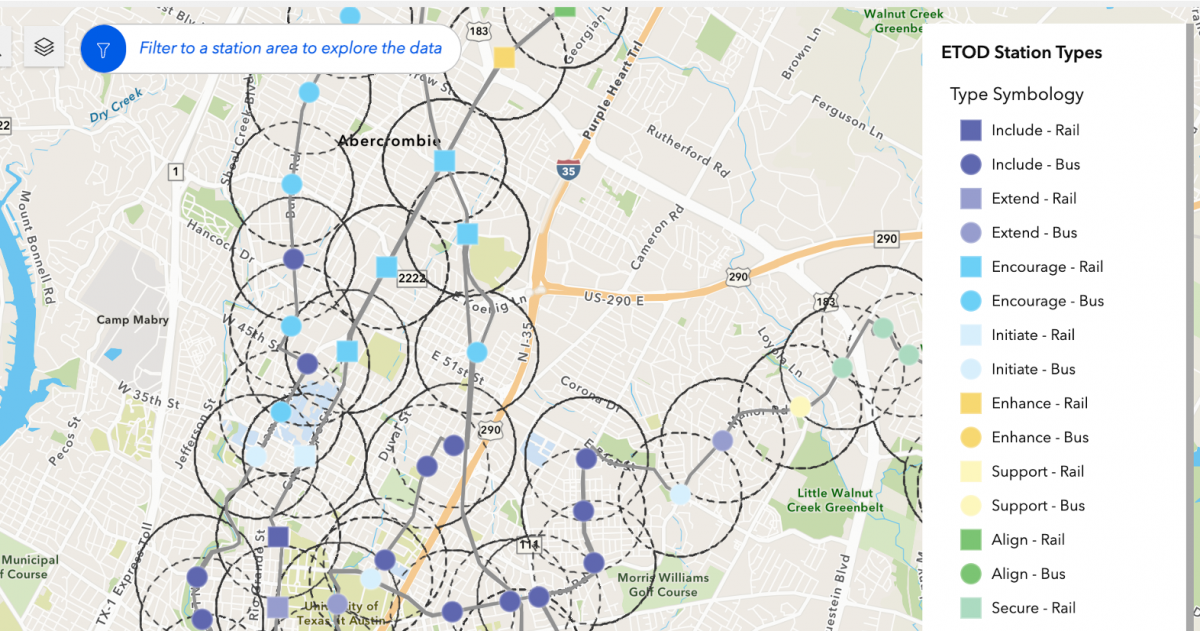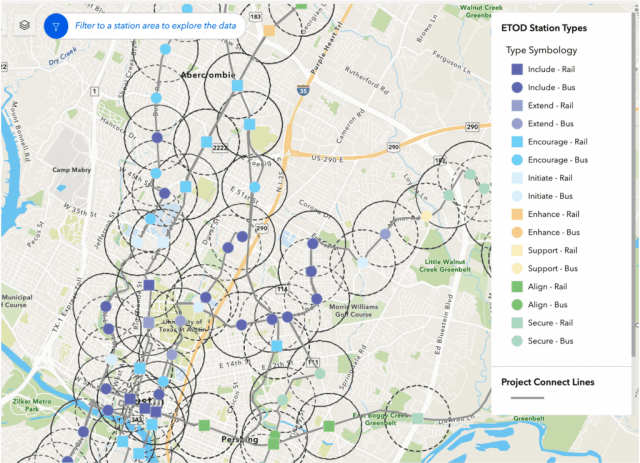
KEY POINTS:
- On February 23, the Austin City Council could approve its “eTOD” policy plan
- Like CodeNEXT, the city’s eTOD plan is designed to rezone huge swaths of existing neighborhoods
- Concerned residents should check City Hall’s eTOD map and contact council members as soon as possible
Later this week, the Austin City Council is set to approve its latest community-wide redesign plan—and it’s one that may not have been on your radar.
On Thursday, February 23, council members will consider City Hall’s ETOD Policy Plan (Item 34) with amendments, which proposes hundreds of new Transit Oriented Districts (TODs) throughout the city. This process will begin immediately within the Northeast Austin Planning Process. eTODs are zoning overlay districts that prescribe compact and dense mixed-use development within mile-wide circles surrounding transit stops. The plan’s authors added an “e” to stand for the idea of “equity,” because TODs are already known to displace vulnerable communities and replace them with younger, higher-income earners.
Austin adopted its first TOD districts in 2005, nine of which are listed in § 25-2-766.04 – TRANSIT ORIENTED DEVELOPMENT DISTRICTS ESTABLISHED AND CLASSIFIED. Only three of these TODs have Station Area and Regulating Plans: Lamar/Justin, MLK Jr, and Plaza Saltillo. Council and Staff are proposing an astonishing ~180 additional ETOD districts, not just on Rail lines but on bus lines too.
You can view a map of the city’s eTOD plan here. Zoom in to see individual transit stops and the circular redevelopment zones proposed around each.
SOURCE: Capital Metro
Here is the sort of redevelopment that this Capital Metro cartoon envisions within each eTOD:
SOURCE: Capital Metro
In the built city, these one-mile diameters reach halfway through many existing neighborhoods. And in the current TOD ordinance, single-family and duplexes are prohibited in the gateway and midway zones.
In addition to areas inside the eTODS, the document proposes “Soft Density by Right” of 4 units in all single-family neighborhoods not within the eTODS, adding the statement that “There are no state laws that bar the City of Austin from implementing soft density by right policies through its zoning and land use ordinances.” The policy plan says “The success metric will be the Number of multi-unit developments built on lots that were previously zoned as single family only.”
The city’s eTOD plan takes things to new heights. It expands Austin’s TOD program by a staggering 2,000%, using transit lines (many of which are movable bus routes) to support policies to rezone most neighborhoods in the community.
Contact Mayor Kirk Watson and your representative on the Austin City Council using the information below. Tell them City Hall’s eTOD plan (Item 34 on their February 23 agenda) threatens Austin’s current residents and its existing affordable housing—just like CodeNEXT did. Check this map if you aren’t sure which council member represents you.
Mayor Kirk Watson:
kirk.watson@austintexas.gov | 512-978-2100
Natasha Harper-Madison (District 1):
natasha.madison@austintexas.gov | 512-978-2101
Vanessa Fuentes (District 2):
vanessa.fuentes@austintexas.gov | 512-978-2102
José Velásquez (District 3):
jose.velasquez@austintexas.gov | 512-978-2103
José “Chito” Vela (District 4):
chito.vela@austintexas.gov | 512-978-2104
Ryan Alter (District 5):
ryan.alter@austintexas.gov | 512-978-2105
Mackenzie Kelly (District 6):
mackenzie.kelly@austintexas.gov | 512-978-2106
Leslie Pool (District 7):
leslie.pool@austintexas.gov | 512-978-2107
Paige Ellis (District 8):
paige.ellis@austintexas.gov | 512-978-2108
Zohaib “Zo” Qadri (District 9):
zohaib.qadri@austintexas.gov | 512-978-2109
Alison Alter (District 10):
alison.alter@austintexas.gov | 512-978-2110
You may send a single email to the mayor and all council members using this form.
